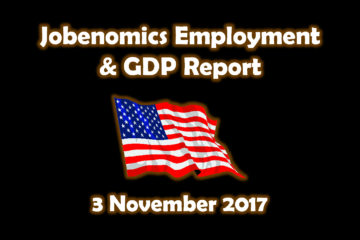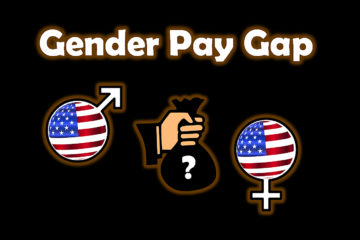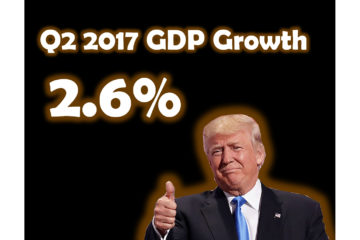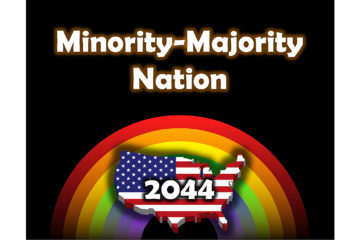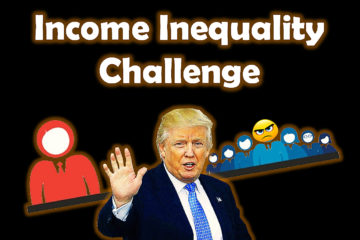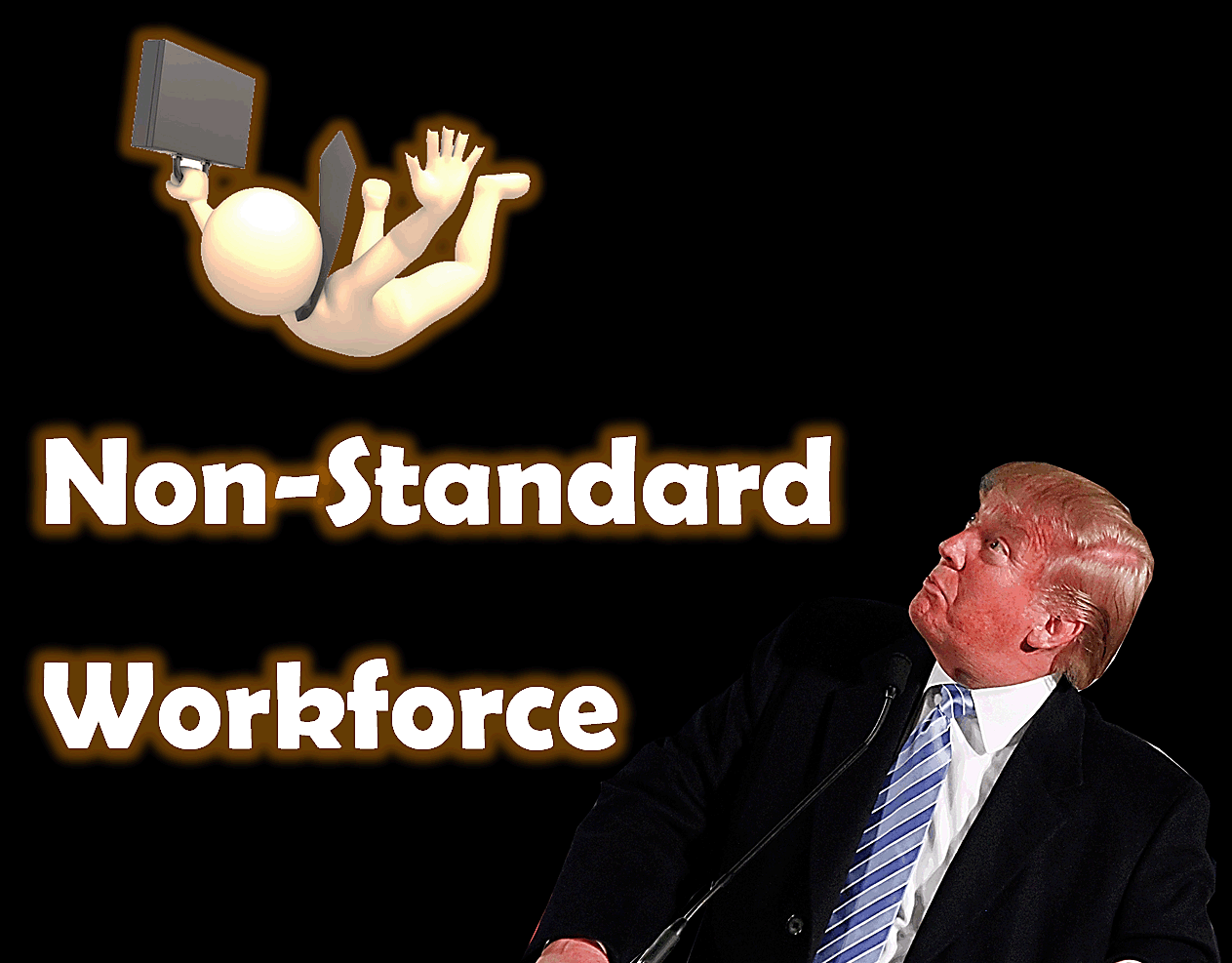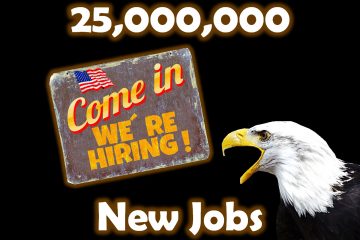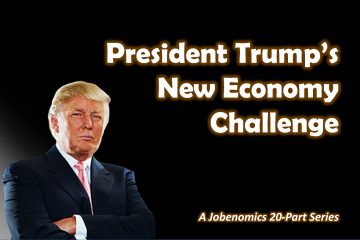Tag: Bureau of Labor Statistics
-
Jobenomics Monthly Employment & GDP Report
Executive Summary. The Trump Administration’s bold economic and job creation vision (i.e., sustained 4% GDP growth and 25 million new jobs) is progressing as planned albeit with some bumps in the road. As addressed in this analysis, recent employment and economic reports present a positive but mixed picture on President Trump’s progress during his first 10-months in office. On the bright side, 261,000 new jobs were created. 250,000 new jobs per month is the standard accepted by most economists to ... -
Gender Pay Gap
The gender pay gap is a highly-charged political and social issue. Unfortunately, few Americans fully understand the data behind gender income inequality. While it is true that American men make more than women, the gap is narrowing. In 2016, American women earned only 2.4% less, or 98 cents on every dollar, than men in similar jobs, according PayScale, a leading U.S. online compensation information company.[1] This 2.4% figure is a far cry from the widely advertised 76% number by activists. ... -
Jobenomics Employment & GDP Report: 9 October 2017
Executive Summary. The Trump Administration’s bold economic and job creation vision (i.e., sustained 4% GDP growth and 25 million new jobs) is facing stiff headwinds from the opposition, Washington and even the weather (Hurricanes). This vision is likely to fall short unless the Trump Administration places as much attention on small and micro-business creation and sustainment as it does on big business. As addressed in this analysis, recent employment and economic reports present a mixed picture on President Trump’s progress ... -
Jobenomics August 2017 Employment Report Analysis
Executive Summary. The two primary sources for U.S. labor force data are the monthly U.S. Bureau of Labor Statistics (BLS) Employment Situation Summary, a monthly summary of all U.S. government and private sector employment, and the ADP National Employment Report, a monthly survey of employment by 400,000 U.S. private sector businesses by the ADP Research Institute in collaboration with Moody’s Analytics. For August 2017, the BLS reported that total nonfarm payroll employment increased by only 156,000 in August, which is ... -
Jobenomics July 2017 Employment Report Analysis
Executive Summary. The two primary sources for U.S. labor force data are the monthly U.S. Bureau of Labor Statistics (BLS) Employment Situation Summary, a monthly summary of all U.S. government and private sector employment, and the ADP National Employment Report, a monthly survey of employment by 400,000 U.S. private sector businesses by the ADP Research Institute in collaboration with Moody’s Analytics. Jobenomics Analysis of the BLS Employment Situation Summary Report. To get a strategic perspective of the state of the ... -
Q2 2017 GDP Growth 2.6%
Real gross domestic product (GDP) increased at an annual rate of 2.6% in the second quarter of 2017 (Q2 2017) according to the “advance” estimate released by the U.S. Bureau of Economic Analysis on 28 July 2017. 2.6% is a positive sign for the U.S. economy and a potential pivot point for President Trump’s bold plan to grow GDP to an annual rate of 4%, create 25 million new jobs and get the “American economy back on track”. To ... -
Jobenomics Analysis of June 2017 U.S. Employment Reports
Executive Summary: The two primary sources for U.S. labor force data are the monthly U.S. Bureau of Labor Statistics (BLS) Employment Situation Summary, a monthly summary of all U.S. government and private sector employment, and the ADP National Employment Report, a monthly survey of employment by 400,000 U.S. private sector businesses by the ADP Research Institute in collaboration with Moody’s Analytics. Recent U.S. Labor Force Gains and Losses (BLS Data) In regard to the working population, the BLS Employment Situation ... -
Analysis of May 2017 U.S. Employment Reports
Executive Summary: May’s employment reports painted a mixed picture for the Trump Administration. The U.S. Bureau of Labor Statistics (BLS) Employment Situation Summary stated in May 2017 the United States produced a total of 138,000 new jobs—a number well below the 250,000 new job standard advocated by most economists. However, the ADP National Employment Report summary reported that the U.S. private sector created 253,000 new jobs of which 77.5% were generated by American small businesses. In regard to the ... -
Jobenomics U.S. Employment Analysis: 5 May 2017
Executive Summary: The U.S. Bureau of Labor Statistics (BLS) Employment Situation Summary stated that in April 2017 the United States produced 211,000 new jobs. The ADP National Employment Report summary reported 177,000 new jobs. Both numbers are below the 250,000 monthly new job threshold set by most economists. In regard to unemployment situation, the BLS reported 146,000 less people “officially unemployed”, which was offset by 162,000 voluntary departures from the labor force to alternative lifestyles or public assistance. Last month’s ... -
Jobenomics U.S. Employment Analysis: 15 April 2017
Jobenomics U.S. Employment Analysis: 15 April 2017 The two primary sources for U.S. labor force data are the monthly U.S. Bureau of Labor Statistics (BLS) Employment Situation Summary, a monthly summary of all U.S. government and private sector employment, and the ADP National Employment Report, a monthly survey of employment by 400,000 U.S. private sector businesses by the ADP Research Institute in collaboration with Moody’s Analytics. The BLS’ March Situation Summary reported a disappointing 98,000 new jobs, which was less ... -
2044 Minority-Majority Nation
President Trump’s New Economy Challenge (Part 19 of 20). President Trump’s Economic Plan estimates a 3.5% annual growth rate that will produce 25 million new jobs this decade. To do so, the Trump Administration will need full support and engagement of America’s minorities to fulfill the President’s Urban Renewal Agenda. Year 2011, marked the first year in U.S. history that minority births exceeded White births. In 2015, over 50% of all U.S. children aged 5 years old were minorities. By 2020, ... -
Trump Administration’s Minimum Wage Conundrum
President Trump’s New Economy Challenge (Part 17 of 20). Most people perceive that minimum wage laws apply mainly to the 4.7 million fast-food industry workers. This perception understates the serious consequences of a universal minimum wage to all businesses, the labor force and the U.S. economy. If a $15/hour minimum wage was implemented today nation-wide for all able-bodied Americans who can work, 159 million citizens would qualify for the minimum wage threshold according to U.S. Census Bureau wage and ... -
President Trump’s Income Inequality Challenge
President Trump’s New Economy Challenge (Part 15 of 20). One of the significant challenges to President Trump, Labor Secretary Acosta and other members of the Trump Administration is dealing with the thorny issue of growing income inequality. The influx of $17 trillion of federal stimuli and trillions of dollars’ worth foreign investment into the U.S. economy since the Great Recession has benefited the rich and decimated the middle class to a greater extent than most people realize. The United States ... -
Lawyer at Labor’s Helm
President Trump’s New Economy Challenge (Part 14 of 20). One might think that the U.S. Department of Labor (DoL) main purpose would be a forward-looking organization that positions the U.S. labor force for major disruptive trends like the emerging digital economy, the contingent workforce and the massive exodus of able-bodied workers. Unfortunately, the opposite seems to be the case. By its own admission, the DoL “fosters and promotes the welfare” of the America’s 140 million workers and enforces several hundred ... -
Jobenomics U.S. Employment Analysis: March 2017
Since President Trump took office, U.S. employment gains have been impressive—a very positive start for the new Administration. The two primary sources for U.S. labor force data are the monthly U.S. Bureau of Labor Statistics (BLS) Employment Situation Summary and the ADP National Employment Report, which is a monthly survey of 400,000 U.S. businesses by the ADP Research Institute in close collaboration with Moody’s Analytics. For January and February 2017, the BLS calculates labor force (government and private sector) gains of 238,000 ... -
President Trump’s Non-Standard Workforce
President Trump’s New Economy Challenge (Part 7 of 20). The Department of Labor Bureau of Labor Statistics (BLS) defines the contingent workforce as the portion of the labor force that has “nonstandard work arrangements” or those without “permanent jobs with a traditional employer-employee relationship.” The ever growing non-standard contingent workforce will consist of over 50% of the U.S. labor force overcoming today’s standard full-time workforce during the next decade. From a Jobenomics perspective, the contingent workforce issue should be the ... -
President Trump’s Gig Workforce
President Trump’s New Economy Challenge (Part 6 of 20). The Trump/Pence Campaign website page entitled, “Donald J. President Trump’s Vision on Economy” listed fifteen key issues affecting the U.S. economy. One major issue that was not listed is the Gig/Contingent Workforce Economy that is one of the largest and least understood elements of the U.S. economy. Today, 40% of all American workers do not have “standard workforce agreements” and make their living on a combination of part-time (a gig) ... -
Why Work Anymore?
President Trump’s New Economy Challenge (Part 5 of 20). Capable adults who are neither employed nor unemployed are not in the labor force. Those who have no job and are no longer looking for a job are counted by the Department of Labor in the Not-in-Labor-Force category. From January 2000 to January 2017, the Not-in-Labor-Force cadre grew from 68,655,000 to 95,102,000, an increase of 26.4 million citizens who more often than not become dependent on public/familial assistance. Today, the number ... -
President Trump’s Small Business Plan?
President Trump’s New Economy Challenge (Part 4 of 20). The only way that President Trump will be able to create 25 million new jobs over the next decade is to mass-produce startup (aka small) businesses. President Trump’s proposed tax and regulatory reductions will provide a welcome relief to small business owners who employ 78% of all Americans and created 74% of all net new jobs this decade. However, much more should be done to mass-produce, highly-scalable small businesses, promote small ... -
The Nexus between Jobs and GDP
President Trump’s New Economy Challenge (Part 3 of 20). President Trump’s vision of a “dynamic and booming economy” is one that can produce a GDP growth rate of “4% over the next decade”. President Trump’s Cabinet has many capable business and financial executives who can make his vision a reality. This reality ultimately depends on mass-producing business, especially small business, creation in order to generate 25 million net new jobs. Sclerotic (0% to 2%) or recessive (negative) GDP rates depreciate a ... -
President Trump’s “Bringing Back Jobs and Growth” Vision
President Trump’s New Economy Challenge (Part 2 of 20). According the White House website, “To get the economy back on track, President Trump has outlined a bold plan to create 25 million new American jobs in the next decade and return to 4 percent annual economic growth….that starts with pro-growth tax reform to help American workers and businesses keep more of their hard-earned dollars.” While the business acumen of President Trump and his Cabinet gives Jobenomics a sense of optimism, Jobenomics ... -
President Trump’s New Economy Challenge
President Trump’s New Economy Challenge (Part 1 of 20). President Trump has outlined a bold plan to create 25 million new American jobs in the next decade and return to 4 percent annual economic growth. Since Jobenomics deals with the economics of business and job creation, the 20 million followers in the Jobenomics National Grassroots Movement enthusiastically support such a bold plan. To make this plan a reality, the incoming Trump Administration will have to focus not only on the old ... -
News on Jobenomics Baltimore City’s Minority-Owned Business Plan
Jobenomics: Baltimore City’s Minority-Owned Business Plan by: Rev. Dr. Alvin C. Hathaway Sr. Special to the AFRO November 30, 2016 Download This Article from Afro-American Newspaper (the Afro-American newspaper is the is the leading news provider for African Americans in the Baltimore/Washington, D.C. Metropolitan area and the longest running African American, family-owned newspaper in the US.) Download Jobenomics Baltimore City Plan The Rev. Dr. Alvin C. Hathaway Sr. (Courtesy Photo) Baltimore has a long history of creating minority-owned businesses and ... -
Jobenomics U.S. Employment Analysis: Q3 2016
Jobenomics U.S. Employment Analysis: Q3 2016 By: Chuck Vollmer 19 November 2016 Jobenomics reports on U.S. unemployment and employment statistics, characteristics and trends. This 140-page Jobenomics U.S. Employment Analysis: Q3 2016 report focuses on the employed and working population, U.S. labor force gains, economic growth, income opportunity, contingent workforce, education and training, workfare, and city and state initiatives. The top three conclusions are: Near-term economic and employment outlook is positive. Mid-term economic and employment outlook is troublesome. Long-term challenges to ... -
Jobenomics U.S. Unemployment Analysis: Q3 2016
Jobenomics U.S. Unemployment Analysis: Q3 2016 By: Chuck Vollmer 28 October 2016 Jobenomics reports on U.S. unemployment and employment statistics, characteristics and trends. This 70-page Jobenomics U.S. Unemployment Analysis: Q3 2016 report focuses on the unemployed and underemployed, labor force losses, economic sustainability, income inequality, voluntary workforce departures and non-working population, welfare, and the small business creation solution. The 140-page Jobenomics U.S. Employment Analysis: Q3 2016 report focuses on the employed and working population, U.S. labor force gains, economic growth, ... -
Jobenomics U.S. Employment Analysis: Q2 2016
Jobenomics U.S. Employment Analysis: Q2 2016 By: Chuck Vollmer 31 July 2016 Download 100-page report at: Jobenomics U.S. Employment Analysis - Q2 2016 - 31 July 2016 Jobenomics reports on U.S. employment and unemployment size, characteristics and trends. This Employment Analysis focuses on the U.S. labor force, business and job creation, and transformative trends—with emphasis on the 60 million workers in the rapidly growing, and underreported, contingent workforce. The companion Unemployment Analysis focuses on how the U.S. government reports on ... -
2016 State of the U.S. Labor Force
2016 State of the U.S. Labor Force By: Chuck Vollmer 11 January 2016 Download a copy of this report at: 2016 U.S. Labor Force State-of-the-Union 11 Jan 2015 Executive Summary. To get a true picture of the 2016 state of the U.S. labor force, one must examine all three labor force categories reported by the U.S. Bureau of Labor Statistics (Employed, Unemployed and Not-in-Labor-Force) as opposed to focusing on the “official” Unemployed rate known as the U3 rate, which represents ... -
Minority-Owned Businesses
Download PDF Version: Minority-Owned Businesses - 10 Jan 2014 Minority-Owned Businesses www.Jobenomics.com By: Chuck Vollmer 10 January 2014 Executive Summary. Today, there are 6 million minority-owned businesses in the US. Jobenomics advocates a national goal of 18 million by year 2020—a goal that is achievable and necessary. Race and ethnicity are important elements of America’s economic equation. Jobenomics forecasts that income opportunity (see Income Inequality versus Opportunity posting) will become a leading domestic issue as minorities assert their growing demographic, ... -
Fastest Growing Occupations
Download PDF Version: Fastest Growing Occupations - 22 Oct 2013 22 October 2013 As discussed in the latest monthly Jobenomics Employment Report, 84.3% of all new jobs this decade have been created in four of the thirteen US industry groups. The fastest growing industry is Professional and Business Services with 2.131 million new jobs followed by Trade, Transportation and Utilities with 1.498 million; Education and Health Services with 1.385 million; and Leisure and Hospitality with 1.278 million for a grand ... -
Consumption-Based Economy
Download PDF Version: Consumption-Based Economy 2 Sep 2013 2 September 2013 The USA is a consumption-based economy and America is a consumption-driven society. Neither fact is necessarily good or bad. It is the way America has operated for a century. The issues at hand are (1) whether America can sustain high rates of consumption in an ever changing geo-political/economic environment, and (2) what are the consequences of a reduced consumption-based economy? Consumption is an economic function that is defined as ...


